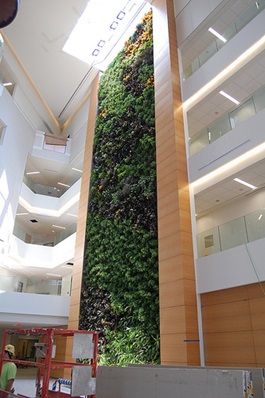 PISB Bio Wall Panorama.
PISB Bio Wall Panorama.
Photo taken by Sean Corbett.
The centerpiece of Drexel University’s new Papadakis Integrated Sciences Building is a 22-foot wide, 80-foot tall biowall—a beautiful and functional wall of plants that purifies indoor air. Designed by Nedlaw Living Walls and maintained by a Parker Plants, Drexel’s biowall is North America’s largest living biofilter and the only such structure installed at a U.S. university.
It consists of over twelve different varieties of tropical plants that grow in the absence of soil. The plant roots are embedded between two layers of woven, porous material. Water is recirculated down the wall between these layers, providing plant roots with nutrients and hydration.
How It Works
Previous research has shown that the microbial communities found on the plants’ roots are crucial to the wall’s function as a biofilter. In essence, bacteria and fungi utilize harmful airborne pollutants as food, breaking down volatile organic compounds (VOCs) such as benzene, toluene, methyl-ethyl ketone, and formaldehyde. These compounds are delivered to the microbes by actively drawing air through the biowall via the HVAC system. Once the air passes through the first layer of the rooting material, many of the VOCs dissolve in the recirculating water, delivering a source of carbon to the root-associated microbes. These pollutants can then be broken down into more benign molecules, namely carbon dioxide and water. By removing these harmful chemicals, this process generates purified air, which is redistributed throughout the building using the HVAC system. It has been estimated that biowall systems similar to that in Drexel’s PISB are capable of removing 60-90% of pollutants with a single pass while reducing overall airborne pollutant concentrations by more than 25% (Nedlaw).
Health Benefits
The air in indoor environments is contaminated by chemicals emitted from the materials, activities, and even the occupants of the building. Many of these chemicals are VOCs, which can promote chronic health problems such as cancer and “sick building syndrome,” along with decreased productivity. Typically indoor air is diluted with fresh, outdoor air to reduce pollutant levels; this is a very costly process that requires heating or cooling the outdoor air to achieve a comfortable indoor temperature. And while adsorptive filters can perform a role similar to that of the biowall microbes, these filters simply trap the harmful chemicals, requiring frequent replacement and disposal.
The biowall technology has been shown to yield indoor air that approaches the quality of fresh air from the rural outdoors and can generate between 1600 and 3000 cubic feet of “outside air “per minute. This is enough fresh air to meet two thirds of the fresh air requirements of 300-600 people, depending on the operation of the biofilter and the ongoing activities in the space (Nedlaw). Thus, the biowall offers a sustainable approach to promoting a healthier indoor environment—one that is green in both a literal and environmental sense.